 W
WAcarapis woodi is an internal parasite affecting honey bees, the symptoms of infestation was originally observed on the Isle of Wight in 1904, but was not described until 1921. Acarapis woodi mites live and reproduce in the tracheae of the bees. The symptoms of Acarapis woodi infestation were originally called by beekeepers as the Isle of Wight Disease, however it is now called Acarine, after the Subclass to which the mites belong. All mites are arachnids like spiders. The female mite attaches 5–7 eggs to the tracheal walls, where the larvae hatch and develop in 11–15 days to adult mites. The mites parasitize young bees up to two weeks old through the tracheal tube openings. There, they pierce the tracheal tube walls with their mouthparts and feed on the haemolymph of the bees. More than a hundred mites can populate the tracheae and weaken the bees. The mites are generally less than 175 micrometres (0.007 in) long, and can only be seen and identified under a microscope.
 W
WAugochlorini is a tribe of sweat bees in the subfamily Halictinae. They are found in the Nearctic and Neotropic realms. They typically display metallic coloration, with many species that are red, gold, green, blue, or purple.
 W
WA bee tree is a tree in which a colony of honey bees makes its home. A colony of bees may live in a bee tree for many years. Most bee trees have a large inner hollow, often with an upper and lower entrance.
 W
WBeekeeping in Ukraine is a major economic activity. Approximately 700,000 people, 1.5% of the Ukrainian population, are engaged in the production of honey. Ukraine is ranked as the number one country in Europe and among the top five countries in the world for honey production, producing 75 thousand metric tons annually. Ukraine produces the greatest quantity of honey per capita in the world.
 W
WBeelining is an ancient art used to locate feral bee colonies. It is performed by capturing and marking foraging worker bees, then releasing them from various points to establish the direction and distance of the colony's home. Beeliners generally have homemade capture boxes which aid them in their quest.
 W
WFrank Benton was an American entomologist, researcher, beekeeping innovator and author.
 W
WBombus morawitzi is a bumblebee species in the subgenus Sibiriocobombus endemic to Central Asia, particularly mountainous regions of Afghanistan, China, Kazakhstan, Kyrgyzstan, and Tajikistan.
 W
WThe brood comb is the beeswax structure of cells where the queen bee lays eggs. It is the part of the beehive where a new brood is raised by the colony. During the summer a good queen may lay 1500-2000 eggs per day, which results in 1500-2000 bees hatching after the three-week development period.
 W
WWilliam Broughton Carr (1836–1909), was a British author and beekeeper. He invented a type of beehive.
 W
WCaupolicana is a genus of bees in the family Colletidae, native to the Americas; most species are crepuscular in habit, visiting flowers only at dawn and/or dusk. There are over 50 known species, in 4 subgenera.
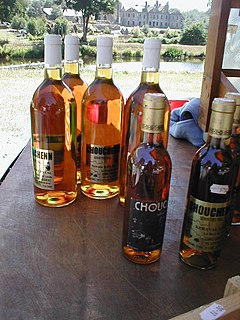 W
WChouchen is an alcoholic beverage native to Brittany. A form of mead, it is made from the fermentation of honey in water. Chouchen normally contains 14% alcohol by volume. Traditionally, buckwheat honey is used, and this imparts chouchen's strong colour and pronounced flavour.
 W
WColletes compactus is a species of ground-nesting bee in the genus Colletes.
 W
WColletes hyalinus, the hyaline cellophane bee, is a species of hymenopteran in the family Colletidae. It is found in North America.
 W
WColletes inaequalis is a common species of plasterer bee, native to North America.
 W
WColletes latitarsis, the broad-footed cellophane bee, is a species of cellophane or plasterer, masked, and fork-tongued bees in the family Colletidae. It is found in North America.
 W
WColletes marginatus is a species of solitary bee of the family Colletidae. The female only gather pollen from flowers of the family Fabaceae, including species like Trifolium arvense, Melilotus albus and Melilotus officinalis.
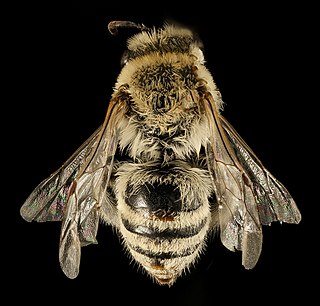 W
WColletes phaceliae, the phacelia cellophane bee, is a species of hymenopteran in the family Colletidae. It is found in North America.
 W
WColletes thoracicus, the rufous-chested cellophane bee, is a species of cellophane or plasterer, masked, or fork-tongued bee in the family Colletidae. It is found in North America.
 W
WThomas William Cowan (1840–1926) was a co-founder and president of the British Beekeepers' Association.
 W
WCubital index is the ratio of two of the wing vein segments of honeybees. The cubital index is used in morphology, the study of form and structure, one way to differentiate species and sub species of living organisms. The pattern of the veins of the fore wings is specific for each breed of bees. The cubital index is consistent for a given race of bee. It can be used to distinguish between similar populations of honeybees and to determine degrees of hybridization.
 W
WDasypoda is a genus of bees in the family Melittidae.
 W
WThe subfamily Dasypodainae is a small subfamily of melittid bees, with more than 100 species in eight genera, found in Africa and the northern temperate zone, primarily in xeric habitats.
 W
W2-Decendioic acid is a constituent of royal jelly.
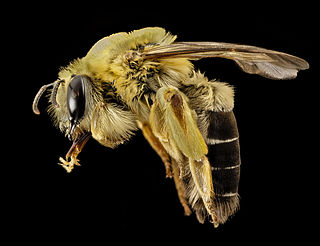 W
WDiphaglossinae is a subfamily of diphaglossinae, fork- and feather-tongued bees in the family Colletidae. There are about 11 genera and more than 130 described species in Diphaglossinae.
 W
WEuhesma is a genus within the bee family Colletidae found in Australia. There are over 90 species described. The group lacks strong unifying features and maybe further split in the future. The type species is Euhesma wahlenbergiae.
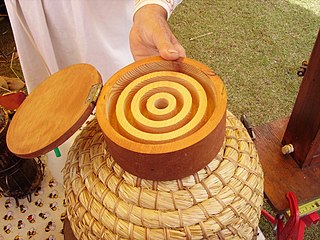 W
WA feeder is a vessel or contraption used by beekeepers to feed pollen or honey to honey bees from a honey bee colony.
 W
WHomalictus blackburni is an Australian species of sweat bee found in moist coastal regions of Queensland and the Northern Territory. Like most halictid bees they nest underground where they provision their larvae with pollen. Homalictus blackburni are shiny black which contrasts with the colour of pollen collected. It was first described by Cockerell in 1910.
 W
WA honey super is a part of a commercial or other managed beehive that is used to collect honey. The most common variety is the "Illinois" or "medium" super with a depth of 65⁄8 inches, in the length and width dimensions of a Langstroth hive.
 W
WHylaeus affinis, the eastern masked bee, is a species of hymenopteran in the family Colletidae. It is found in North America.
 W
WHylaeus annulatus, the annulate masked bee, is a species of hymenopteran in the family Colletidae. It is found in North America and Europe.
 W
WHylaeus azorae is a species of bee in the family Colletidae. It is known only from the island of Pico in the Azores.
 W
WHylaeus basalis, the cinquefoil masked bee, is a species of hymenopteran in the family Colletidae. It is found in North America.
 W
WHylaeus euxanthus, the yellow collared masked bee, is a species of hymenopteran in the family Colletidae. It is found in Australia.
 W
WHylaeus hyalinatus, the hyaline spatulate-masked bee, is a species of hymenopteran in the family Colletidae. It is found in North America.
 W
WHylaeus leptocephalus, the slender-faced masked bee, is a species of hymenopteran in the family Colletidae. It is found in North America.
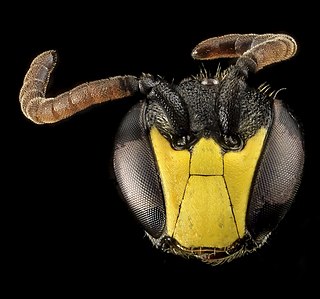 W
WHylaeus modestus, known generally as the modest masked bee or yellow-faced bee, is a species of hymenopteran in the family Colletidae. It is found in North America.
 W
WHylaeus ornatus, the ornate masked bee, is a species of hymenopteran in the family Colletidae. It is found in North America.
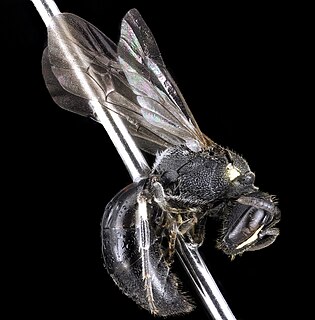 W
WHylaeus schwarzii, or Schwarz's masked bee, is a species of hymenopteran in the family Colletidae. It is found in North America.
 W
WHylaeus verticalis, the vertical masked bee, is a species of hymenopteran in the family Colletidae. It is found in North America.
 W
WThe June gap occurs in Ireland and Great Britain when there is a shortage of forage available for honey bees, typically occurring in June.
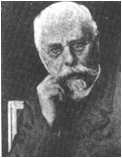 W
WGeorges de Layens was a French botanist and apiculturalist. He was the creator of a popular mobile beehive called the "Layens hive". The standard author abbreviation Layens is used to indicate this person as the author when citing a botanical name.
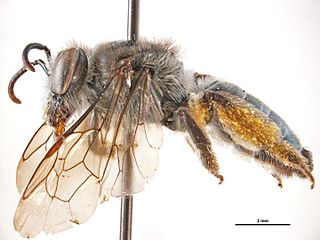 W
WLeioproctus carinatifrons is a species of Australian bee. It is found in coastal regions of New South Wales, Victoria and South Australia, and feeds on the nectar of various species of Persoonia. It was first described in 1929 by T. D. A. Cockerell as Paracolletes carinatifrons. Males are around 10 millimetres (0.39 in) long, and females 7 mm (0.28 in). It is closely related to L. perpolitus from Western Australia
 W
WMacropis is a genus of bees.
 W
WMeganomiinae is a subfamily of melittid bees, with 10 species in four genera, found only in Africa, primarily in xeric habitats, with the distributional limits in Yemen and Madagascar. They are rather different in appearance from the other groups of past/present melittids, being large bees (10–22 mm), mostly black with strong yellow markings, resembling anthidiine megachilids. Males of this subfamily are known to have hidden sterna.
 W
WMelitta is a genus of bees in the family Melittidae. It includes about 40 species restricted to Africa and the northern temperate zone. Most of the species are Palaearctic, though three rare species occur in North America.
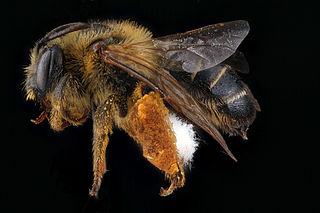 W
WMelitta eickworti, the deerberry melitta, is a species of melittid bee in the family Melittidae. It is found in North America.
 W
WMelittidae is a small bee family, with over 200 described species in three subfamilies. The family has a limited distribution, with all described species restricted to Africa and the northern temperate zone.
 W
WMelittology is a branch of entomology concerning the scientific study of bees. It may also be called apicology. Melittology covers the species found in the clade Anthophila within the superfamily Apoidea, comprising more than 20,000 species, including bumblebees and honey bees.
 W
WMidus is a type of Lithuanian mead, an alcoholic beverage made of grain, honey and water. Balts were making mead for thousands of years. Old Lithuanian mead was made from a solution of honey and water simmered with various spices, such as thyme, lemon, cinnamon, cherries, linden blossoms, juniper berries, and hops. Today Midus is produced by several companies and is to be found in the majority of liquor shops in the US and supermarkets in Lithuania.
 W
WRoger A. Morse, Ph.D. was an American bee biologist who taught many beekeepers both the rudiments and the finer practices, through his research and publications. During his long career, three new parasites of the honeybee, acarine mite, varroa mite and African small hive beetle were introduced to the United States. These, along with the Africanized honeybee and pesticide kills were all important beekeeping issues. Morse was extensively involved in research on each of these and provided guidance to the beekeeping industry.
The Nasonov pheromone is released by worker bees to orient returning forager bees back to the colony. To broadcast this scent, bees raise their abdomens, which contain the Nasonov glands, and fan their wings vigorously.
 W
WNerolic acid, also known as (Z)-3,7-Dimethyl-2,6-octadienoic acid is one of seven chemicals found in the Nasonov scent gland of honey-bees along with geraniol, geranic acid, (E)-citral, (Z)-citral, (E,E)-farnesol, and nerol. Of these, nerolic acid, geraniol, and (E,E)-farnesol are present in the highest proportions.
 W
WNickerson Farms was an American roadside restaurant franchise that existed between the mid-1960s and the early 1980s. It was started by I. J. Nickerson, a former Stuckey's franchisee who did not agree with that chain's rules and regulations. Nickerson Farms had as many as sixty restaurants located along Interstate highways, mainly in the Midwestern United States. Each Nickerson Farms location had a full-room restaurant, with a gift shop. Honey, collected from on-site beehives, could also be purchased at Nickerson Farms stores.
 W
WOligoapis beskonakensis is an extinct bumblebee from the Oligocene rocks of Beş Konak, Turkey.
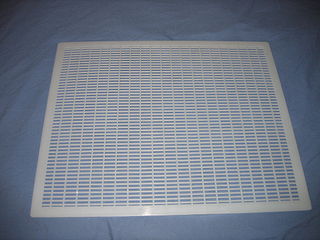 W
WIn beekeeping, a queen excluder is a selective barrier inside the beehive that allows worker bees but not the larger queens and drones to traverse the barrier. Queen excluders are also used with some queen breeding methods. Some beekeepers believe that excluders lead to less efficient hives as often worker bees, not used to travelling through the excluder, are intimidated and stay in the lower brood box. This can lead to rapid filling of the brood box and overcrowding resulting eventually in the hive swarming.
 W
WRediviva is a genus of bees in the Melittidae family endemic to South Africa.
 W
WSlumgum in beekeeping is the residue of the beeswax rendering process.
 W
WThe Stenotritidae is the smallest of all formally recognised bee families, with only 21 species in two genera, all of them restricted to Australia. Historically, they were generally considered to belong in the family Colletidae, but the stenotritids are presently considered their sister taxon, and deserving of family status. Of prime importance is that the stenotritids have unmodified mouthparts, whereas colletids are separated from all other bees by having bilobed glossae.